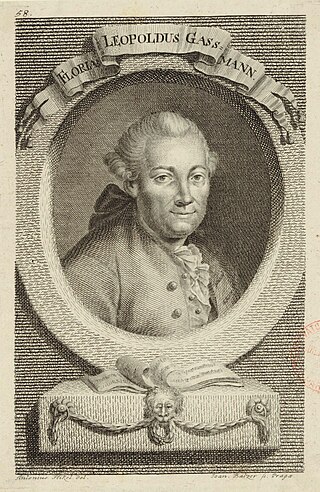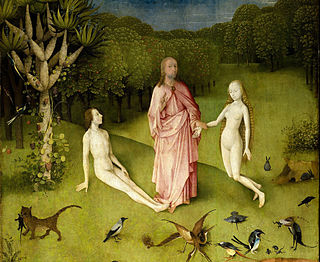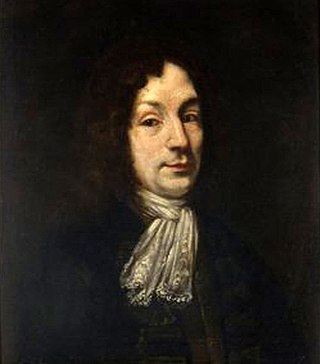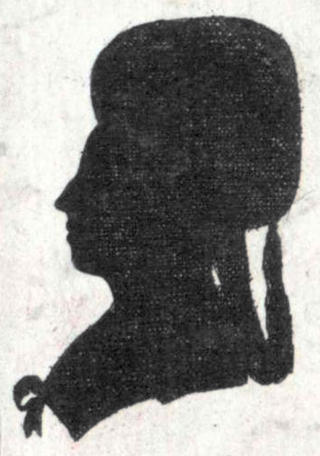
The Creation is an oratorio written in 1797 and 1798 by Joseph Haydn, and considered by many to be one of his masterpieces. The oratorio depicts and celebrates the creation of the world as described in the Book of Genesis.

The Seasons is a secular oratorio by Joseph Haydn, first performed in 1801.

Gottfried Freiherr van Swieten was a Dutch-born Austrian diplomat, librarian, and government official who served the Holy Roman Empire during the 18th century. He was an enthusiastic amateur musician and is best remembered today as the patron of several great composers of the Classical era, including Joseph Haydn, Wolfgang Amadeus Mozart, and Ludwig van Beethoven.

Johann Adam Joseph Karl Georg Reutter, during his life known as Georg Reutter the Younger was an Austrian composer. According to David Wyn Jones, in his prime he was "the single most influential musician in Vienna".

Florian Leopold Gassmann was a German-speaking Bohemian opera composer of the transitional period between the baroque and classical eras. He was one of the principal composers of dramma giocoso immediately before Mozart. He was one of Antonio Salieri’s teachers.
Sandrine Piau is a French soprano. She is particularly renowned in Baroque music although also excels in Romantic and modernist art songs. She has the versatility to perform works from Vivaldi, Handel, Mozart to Schumann, Debussy, and Poulenc. In addition to an active career in concerts and operas, she is prolific in studio recordings, primarily with Harmonia Mundi, Naïve, and Alpha since 2018.

The composers Wolfgang Amadeus Mozart (1756–1791) and Joseph Haydn (1732–1809) were friends. Their relationship is not very well documented, but the evidence that they enjoyed each other's company is strong. Six string quartets by Mozart are dedicated to Haydn.

Malin Hartelius is a Swedish soprano who performs regularly with conductors such as Nikolaus Harnoncourt, Ton Koopman, Riccardo Chailly, Sir John Eliot Gardiner, Peter Schreier, Herbert Blomstedt, and Frans Brüggen. She has collaborated with orchestras like the Oslo Philharmonic Orchestra, the Tonhalle Orchester Zurich, the San Francisco Symphony, and the Concentus Musicus Wien.

AnnaSelina Storace, known professionally as Nancy Storace, was an English operatic soprano. The role of Susanna in Mozart's Le nozze di Figaro was written for and first performed by her.

Joyce Arleen Auger was an American coloratura soprano, known for her interpretations of works by Bach, Handel, Haydn, Monteverdi, Mozart, and Schubert. She won a posthumous Grammy Award for "Best Classical Vocal Performance" in 1994.

Marianna Martines, also Marianne von Martinez, was a composer, pianist, and singer of the classical period, based in Vienna, Austria who knew Mozart and Haydn.

Martin Pearlman is an American conductor, harpsichordist, composer, and early music specialist. He founded the first permanent Baroque orchestra in North America with Boston Baroque in 1973–74. Many of its original players went on to play in or direct other ensembles in what became a growing field in the American music scene. He later founded the chorus of that ensemble and has been the music director of Boston Baroque from its inception up to the present day.

The Creation, the oratorio by Joseph Haydn, is structured in three parts. He composed it in 1796–1798 on German text as Die Schöpfung. The work is set for soloists, chorus and orchestra. Its movements are listed in tables for their form, voice, key, tempo marking, time signature and source.

Luca Antonio Predieri was an Italian composer and violinist. A member of a prominent family of musicians, Predieri was born in Bologna and was active there from 1704. In 1737 he moved to Vienna, eventually becoming Kapellmeister to the imperial Habsburg court in 1741, a post he held for ten years. In 1765 he returned to his native city where he died two years later at the age of 78. A prolific opera composer, he was also known for his sacred music and oratorios. Although his operas were largely forgotten by the end of his own lifetime and most of their scores lost, individual arias as well some of his sacred music are still performed and recorded.

The Tonkünstler-Societät was a benevolent society for musicians in Vienna, which lasted from the mid-18th century to the mid-20th. Its purpose was "to support retired musicians and their families". Beginning in 1772, the Society mounted a series of benefit concerts, often with large forces of performers, at which were performed works by leading Classical-period composers, including Joseph Haydn, Wolfgang Amadeus Mozart, and Ludwig van Beethoven.

The Beethoven concert of 22 December 1808 was a benefit concert held for Ludwig van Beethoven at the Theater an der Wien in Vienna that featured the public premieres of Beethoven's Fifth and Sixth Symphonies, the Fourth Piano Concerto and the Choral Fantasy. This concert, then called an Akademie, occurred in a very cold hall and lasted for approximately four hours. Its featured performers were an orchestra, chorus, vocal soloists, and the composer was featured as soloist at the piano. Beethoven biographer Barry Cooper refers to the concert, in terms of its content, as the "most remarkable" of Beethoven's career.
La passione di Gesù Cristo, is a 1794 Italian-language oratorio for soloists, choir and orchestra by Simon Mayr, to an adapted version of the famous libretto La passione di Gesù Cristo by Metastasio. Unlike Mayr's four Latin-language oratorios to librettos by Giuseppe Foppa for the Conservatorio dei Mendicanti, La passione was written for a church, and not limited to girls voices.
The Wiener Tonkünstler-Orchester was an orchestra association in Vienna, which existed until 1933.

Therese Barbara Alberta Teyber was an Austrian operatic soprano.
















